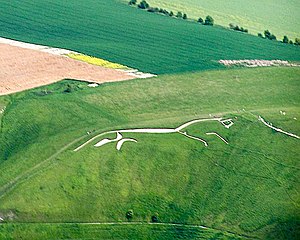Translation of Wikipedia article on the Cherhill White Horse into Occidental
Tuesday, July 22, 2008
Just a few hours after the translation of a Wikipedia article on the did you know...? section about types of wine made without grapes, I've translated another article that will be going up in the same section in a few hours, about the Cherhill White Horse, one of the hill figures you can sometimes find in England, the most famous of which is the Uffington White Horse:

Paying close attention to the articles going up on the did you know...? section by the way is a very good way to become informed on areas of knowledge you never would have thought to read about alone. Highly recommended.
The translation, as always, is an attempt to get some attention paid to international auxiliary languages. Occidental is another good language that can be read quite well without much training. I'm still new at it so please leave any corrections below in the comments section if/when you find errors:
| English | Occidental |
|---|---|
The Cherhill White Horse is a hill figure on Cherhill Down, in the county of Wiltshire, England. Dating from the late 18th century, it is the second oldest of several similar white horses to be seen around Wiltshire, with only the Westbury White Horse being older. The figure is also sometimes called the Oldbury White Horse. 'Cherhill' is pronounced as if spelt Cherrill. | Li Blanc Cavalle de Cherhill (anglesi: Cherhill White Horse) es un coline-figura sur Cherhill Down, in li comtia de Wiltshire, Angleterre*. Datante del tard 18im secul, it es li duesim old de pluri simil blanc cavalles queles posse esser videt circum Wiltshire, e sol li Blanc Cavalle de Westbury es plu old. Li figure es anc quelcvez nominat li Blanc Cavalle de Oldbury. Li pronunsation de 'Cherhill' es quam 'Cherrill'. |
Location Facing towards the north-east, the Cherhill White Horse lies on a steep slope of Cherhill down, a little below the earthwork known as Oldbury Castle, and can be seen from the A4 road and the nearby village of Cherhill. A good viewpoint is a lay-by alongside the westbound carriageway of the A4 where it passes below the horse. From near here, a footpath climbs the hill towards the horse itself. Near the Horse is an obelisk called the Lansdowne Monument, visible in some photographs of the White Horse. This is a 38-metre stone structure, erected in 1845 by the 3rd Marquess of Lansdowne to commemorate his ancestor Sir William Petty. | Situation Li Blanc Cavalle de Cherhill fronta al nord-ost, e jaca sur un declivi scarp de Cherhill down, un poc sub li diga conosset quam Oldbury Castelle, e posse esser videt del Via A4 e li proxim village de Cherhill. Un bon punctu de vista es un halta along li strade eante west, quande it passa sub li cavalle. De proxim a ci, un ped-via ascende li coline al cavalle. Proxim al cavalle es un obelisco nominat li Lansdowne Monument, visibil in alcun fotos del Blanc Cavalle. Ti es un structura de petre de 38 metres, erectet in 1845 per li Triesim Marqueso de Lansdowne por comemorar su antecessor, Sir William Petty. |
| Inspiration The Cherhill horse may have been inspired by the first such Wiltshire horse, that at Westbury, which had just been remodelled. The origins of the Westbury horse are more obscure. Unlike the Uffington White Horse in Berkshire, which has been shown to date from the Bronze Age, the earliest evidence of the existence of the Westbury horse is in a paper published by the Rev. Francis Wise in 1742. A bold theory for the origin of the first Wiltshire horse is that it commemorates Alfred the Great's victory over the Danes at the Battle of Ethandun, 878. Another is that it was carved in the early 18th century as a show of loyalty to the new royal house, the House of Hanover, the white horse being an heraldic symbol of the Electorate of Hanover. One writer on the subject has commented "...the hillside white horse can be a slippery creature, and the origins of some are impossible to establish with any certainty." | Inspiration Li cavalle de Cherhill posse ha esset inspirat per li unesim Wiltshire-cavalle, to in Westbury, quel apen hat esset re-modellat. Li orígines del Westbury-cavalle es plu obscur. Ne simil al Blanc Cavalle de Uffington in Berkshire, quel se monstra un etá del Bronzin Era, li plu tost testimonie del cavalle de Westbury es un papere publicat del Rev. Francis Wise in 1742. Un audaci teorie por li orígine del unesim cavalle de Wiltshire es que it comemora li victorie de Alfred li Grand sur li Danes in li Batallie de Ethandun, in 878. Un altri es que it esset tranchat in li tost 18im secul quam un spectacul de loyalitá al nov reyal dom, li Dom de Hanover, proque li blanc cavalle es un heraldic simbol del Electoratu de Hanover. Un scritor sur li subjecte ha comentat que "...li cavalle del coline-látere posse esser un glissid ente, e li origines de alcun es ínpossibil a establisser con alquel certitá." |








0 comments:
Post a Comment